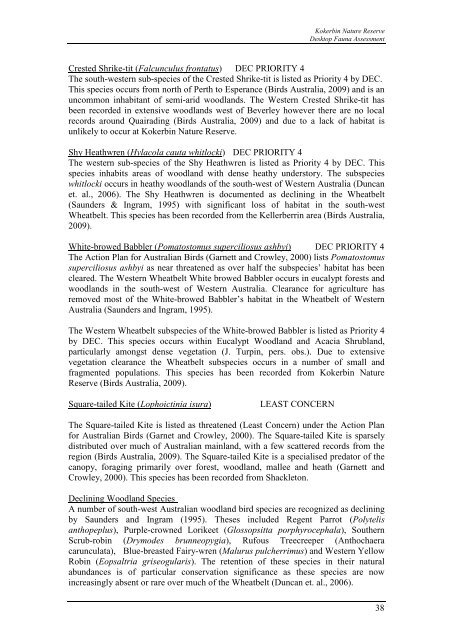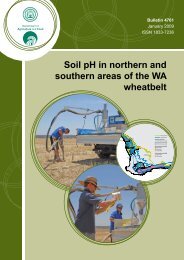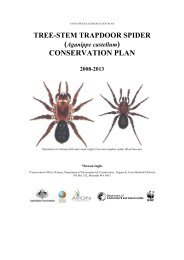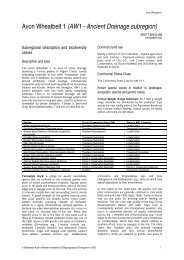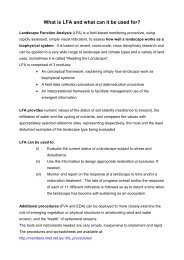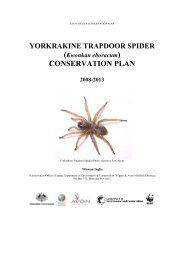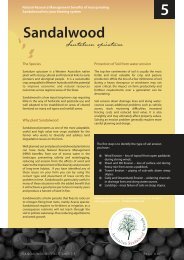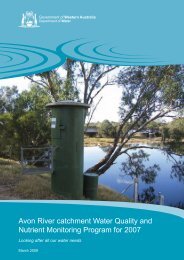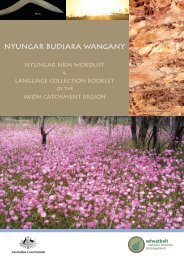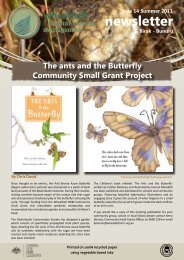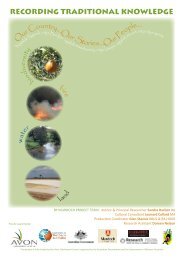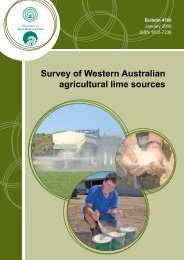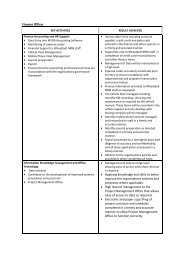Kokerbin Nature Reserve Desktop Fauna ... - Wheatbelt NRM
Kokerbin Nature Reserve Desktop Fauna ... - Wheatbelt NRM
Kokerbin Nature Reserve Desktop Fauna ... - Wheatbelt NRM
You also want an ePaper? Increase the reach of your titles
YUMPU automatically turns print PDFs into web optimized ePapers that Google loves.
<strong>Kokerbin</strong> <strong>Nature</strong> <strong>Reserve</strong><br />
<strong>Desktop</strong> <strong>Fauna</strong> Assessment<br />
Crested Shrike-tit (Falcunculus frontatus) DEC PRIORITY 4<br />
The south-western sub-species of the Crested Shrike-tit is listed as Priority 4 by DEC.<br />
This species occurs from north of Perth to Esperance (Birds Australia, 2009) and is an<br />
uncommon inhabitant of semi-arid woodlands. The Western Crested Shrike-tit has<br />
been recorded in extensive woodlands west of Beverley however there are no local<br />
records around Quairading (Birds Australia, 2009) and due to a lack of habitat is<br />
unlikely to occur at <strong>Kokerbin</strong> <strong>Nature</strong> <strong>Reserve</strong>.<br />
Shy Heathwren (Hylacola cauta whitlocki) DEC PRIORITY 4<br />
The western sub-species of the Shy Heathwren is listed as Priority 4 by DEC. This<br />
species inhabits areas of woodland with dense heathy understory. The subspecies<br />
whitlocki occurs in heathy woodlands of the south-west of Western Australia (Duncan<br />
et. al., 2006). The Shy Heathwren is documented as declining in the <strong>Wheatbelt</strong><br />
(Saunders & Ingram, 1995) with significant loss of habitat in the south-west<br />
<strong>Wheatbelt</strong>. This species has been recorded from the Kellerberrin area (Birds Australia,<br />
2009).<br />
White-browed Babbler (Pomatostomus superciliosus ashbyi) DEC PRIORITY 4<br />
The Action Plan for Australian Birds (Garnett and Crowley, 2000) lists Pomatostomus<br />
superciliosus ashbyi as near threatened as over half the subspecies’ habitat has been<br />
cleared. The Western <strong>Wheatbelt</strong> White browed Babbler occurs in eucalypt forests and<br />
woodlands in the south-west of Western Australia. Clearance for agriculture has<br />
removed most of the White-browed Babbler’s habitat in the <strong>Wheatbelt</strong> of Western<br />
Australia (Saunders and Ingram, 1995).<br />
The Western <strong>Wheatbelt</strong> subspecies of the White-browed Babbler is listed as Priority 4<br />
by DEC. This species occurs within Eucalypt Woodland and Acacia Shrubland,<br />
particularly amongst dense vegetation (J. Turpin, pers. obs.). Due to extensive<br />
vegetation clearance the <strong>Wheatbelt</strong> subspecies occurs in a number of small and<br />
fragmented populations. This species has been recorded from <strong>Kokerbin</strong> <strong>Nature</strong><br />
<strong>Reserve</strong> (Birds Australia, 2009).<br />
Square-tailed Kite (Lophoictinia isura)<br />
LEAST CONCERN<br />
The Square-tailed Kite is listed as threatened (Least Concern) under the Action Plan<br />
for Australian Birds (Garnet and Crowley, 2000). The Square-tailed Kite is sparsely<br />
distributed over much of Australian mainland, with a few scattered records from the<br />
region (Birds Australia, 2009). The Square-tailed Kite is a specialised predator of the<br />
canopy, foraging primarily over forest, woodland, mallee and heath (Garnett and<br />
Crowley, 2000). This species has been recorded from Shackleton.<br />
Declining Woodland Species<br />
A number of south-west Australian woodland bird species are recognized as declining<br />
by Saunders and Ingram (1995). Theses included Regent Parrot (Polytelis<br />
anthopeplus), Purple-crowned Lorikeet (Glossopsitta porphyrocephala), Southern<br />
Scrub-robin (Drymodes brunneopygia), Rufous Treecreeper (Anthochaera<br />
carunculata), Blue-breasted Fairy-wren (Malurus pulcherrimus) and Western Yellow<br />
Robin (Eopsaltria griseogularis). The retention of these species in their natural<br />
abundances is of particular conservation significance as these species are now<br />
increasingly absent or rare over much of the <strong>Wheatbelt</strong> (Duncan et. al., 2006).<br />
38


